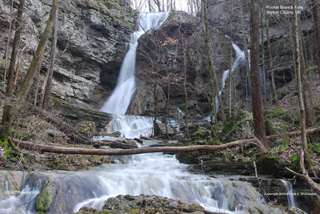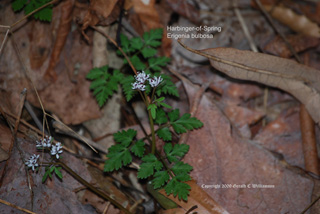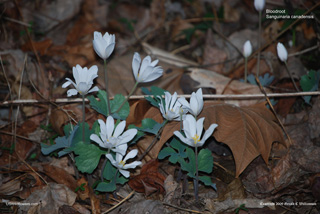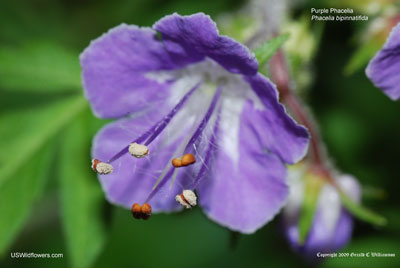Note: The Crockford-Pigeon Mountain Wildlife Management area is now a fee area. Click here for more information on fees. If you are looking for status updates, check the Journal’s “The Pocket” Category.
The Pocket at Pigeon Mountain in Walker County, Georgia is considered to be among the finest areas for wildflowers in Georgia. It is a part of the Crockford-Pigeon Mountain Wildlife Management Area, and is home to the Shirley Miller Wildflower Trail. I’ve compiled some wildflower identification field guides for this area that you can find below.
Getting there: From LaFayette, GA take Hwy 193 North for about 8 miles to Davis Cross roads. Turn left onto Hog Jowl Road and go nearly 3 miles. As you top a hill, Pocket Road is on the left. Drive slowly and carefully along Pocket Road for about a mile, crossing a creek, and then turn left into the parking lot at the end. Walk down the gravel driveway through the handicap parking area to get to the Shirley Miller Wildflower Trail. From south Chattanooga, go south on St. Elmo Avenue and cross the state line into Georgia, where St. Elmo Avenue becomes Georgia 193. Follow Georgia 193 for 18.5 miles to Davis Crossroads (passing thru Flintsone, High Point, and Cooper Heights) and turn right onto Hog Jowl Road. From there follow directions above. Below is a Google map showing the location.
View Larger Map
The Shirley Miller Wildflower Trail contains nearly a quarter of a mile of boardwalk to prevent enthusiasts from overrunning the myriad of wildflowers, and then extends for another several hundred yards beyond the end of the boardwalk up along the creek to a wonderful waterfalls.
The trail past the boardwalk is somewhat rugged, but for those willing and able to make it, it is worth the effort. Just be careful where you are putting your feet as you travel this trail – the wildflowers crowd it all the way to the falls.
While the Shirley Miller Wildflower Trail has enough wildflowers by itself to make several trips in a season worthwhile, other areas of The Pocket have wildflowers in abundance as well, and extending your visits to those other areas of The Pocket are definitely worthwhile. North of the parking area immediately across the little creek are an abundance of wildflowers, and if you continue on that trail up over the next couple ridges toward Blue Bird Gap, there is an excellent area of wildflowers where the trail crosses a creek, in addition to the many that can be found along the trail.
Also as you leave the parking area heading down the driveway to the Shirley Miller Wildflower Trail, there is a horse trail (officially the beginning of The Pocket Loop Trail) that goes uphill to the left around the gate. Along this trail are an abundance of wildflowers throughout the spring. In addition after passing the top of the falls the trail passes through an open field with the flowers you find in that kind of habitat, and continues on through other wildflower-rich areas.
Identifying the abundance of wildflowers in The Pocket can be a challenge. I believe that wildflower references more specific to an area make that task easier – and more pleasant. In addition to the PDF’s you can find below, I recommend Jay Clark’s Wildflowers of Pigeon Mountain. You can pick up a copy at the nearby Pigeon Mountain Grill, which is just a couple of miles north of The Pocket at Davis Crossroads. You might want to plan your stop to pick up Jay’s book around meal time. They have good food. Breakfast is available until 10 AM, so breakfast at Davis Crossroads while looking over Jay’s book would be a good way to build enthusiasm for your trip into The Pocket. UPDATE: As of Feb 2014, the Pigeon Mountain Grill is once again serving breakfast after a hiatus of about 2 years. Lunch or dinner is also an option. (I am not associated with the store, and have no financial interest in either the Pigeon Mountain Country Store, or in the sales of Jay Clark’s book.)
I started reporting on my wildflowering trips to The Pocket in February of 2009. You can read reports from prior years and get current status here. You can view an album of photos from those trips. Using the information and photographs from those trips, I have compiled some reference guides that can help you identify wildflowers that may be in bloom during each of the spring bloom periods listed below. Each reference guide is on two 8×11 pages; you can print these off two-sided and carry a single reference page to identify up to 16 wildflowers. Some flowers will continue to be blooming during a later period and may be left off the guide for that date range, so it might be wise to bring the guide for the prior period with you on your trip to The Pocket. Click on the date range to open the PDF file containing the guide. I also have available the checklist I use to track what I find on each trip to The Pocket. Feel free to print and use the checklist; I ask that if you copy or share the list, you keep the “USWildflowers.com” name included in your copy.
Even in north Georgia February is early for wildflowers, but several may start blooming in early- to mid-February. There are 12 photos of 11 wildflowers in the February identification guide, and of these several are just showing foliage or foliage and buds.
- Harbinger-of-Spring (Erigenia bulbosa) is typically the earliest of these, and in 2009 was blooming as early as Feb 7.
- Wild Hydrangea (Hydrangea arborescens) – Last year’s beautiful wild hydrangea blossoms may still be around if they haven’t been washed away by the flooding.
- Sharp-lobed Hepatica (Anemone acutiloba) – Hepatica is an early bloomer, and you may see the white, pink, or blue blossoms as early as mid-February; certainly by the end of February.
- Cutleaf Toothwort (Cardamine concatenata) will be showing buds and perhaps the first few opening blossoms in late February
- Trailing Trillium (Trillium decumbens) will show up with their three leaves along the boardwalk. While the blossoms likely won’t be open, they may show a bit of their red color by the end of February.
- Wood Poppy (Stylophorum diphyllum) – Celandine Poppy – will have some hairy flower buds by the end of February.
- Carolina Spring Beauty (Claytonia caroliniana) flower buds will be showing in late February. You might even catch one of these pink and white beauties open late in the month.
- Virginia Bluebell (Mertensia virginica) foliage will be showing up in late February, and some of the plants may even have some pink flower buds ready to open.
- You’ll be able to spot the Trout Lily (Erythronium americanum) leaves pushing their way up through the leaves in mid-February.
- Bloodroot (Sanguinaria canadensis) will be unfolding their leaves from around the buds in the earliest plants in late February.
- Star Chickweed (Stellaria pubera) should be starting to bloom by late February, frequently early in February.
March 1 – 10:
Early March really starts the wildflower season at The Pocket. It’s worth a visit for those close at hand, although if I could only make one or two trips I’d wait til later. Here is a list of the plants in the March Identification Guide for this time period:
- Virginia Bluebell (Mertensia virginica) – While not at their peak in early March, their pink buds will become abundant, and a few blossoms will likely open up with their beautiful blue color.
- Trout Lily (Erythronium americanum) – These beautiful flowers will likely move into full bloom during the first half of March.
- White Trillium – will be forming their buds, and even though probably not open yet during the 1st half of March, they are beautiful in their pre-bloom form.
- Cutleaf Toothwort (Cardamine concatenata) – While a few of these may have opened in February, they’ll become abundant in early March.
- Sharp-lobed Hepatica (Anemone acutiloba) – This wonderful flower may be dominant during the first part of March.
- Carolina Spring Beauty (Claytonia caroliniana) will be much more than budding.
- Trailing Trillium (Trillium decumbens) will probably start to show some color, but you probably won’t find any fully open yet.
- You’ll probably find some Bloodroot (Sanguinaria canadensis) fully open.
- See if you can spot the Spicebush (Lindera benzoin) blooming along the boardwalk. Remember to look up!
- Rue Anemone (Thalictrum thalictroides) may be starting to add its white color to the landscape; frequently passed by since at a glance they look like Hepatica.
- You may catch an early Bellwort (Uvularia grandiflora) opening it’s hanging yellow blossoms.
- Foamflower may have some buds on the stem arising from last year’s leaves.
- The Wood Poppy (Stylophorum diphyllum) may tease you with a yellow blossom or two ready to open.
- The earliest of the Dutchman’s Breeches (Dicentra cucullaria) will be forming their blossoms now; one or two maybe fully.
March 11-20:
In mid-March the wildflowers really become profuse at The Pocket. I had a difficult time paring down the original 33 photos to 16 for the identification guide for this time period. There are a number of plants that will continue to bloom in mid-March from the early March ID sheet, so you may want to bring it along too.
- The Redbud (Cercis canadensis) trees along the driveway should be starting to bloom
- Trout Lily (Erythronium americanum) should be in abundance in mid-March.
- Bloodroot (Sanguinaria canadensis) will continue bloom during this period, but will be waning.
- Rue Anemone (Thalictrum thalictroides) will likely be blooming.
- Purple Phacelia (Phacelia bipinnatifida) will be beginning to bloom, probably late during this time period, except for a spot or two where some early ones bloom.
- Carolina Spring Beauty (Claytonia caroliniana) should be abundant in mid-March.
- Dutchman’s Breeches (Dicentra cucullaria) will likely have their short bloom period during this time.
- Trailing Trillium (Trillium decumbens) will likely begin blooming during this time.
- The earliest of the Large-flowered Bellwort (Uvularia grandiflora) will be blooming, but the peak for this species will be later in March.
- You may spot a Wild Geranium (Geranium maculatum) during this period; peak is later.
- Hepatica (Anemone acutiloba) will be in white, blue, and pink, probably many.
- Virginia Bluebell (Mertensia virginica) will be blooming, peaking probably in the 3rd or 4th week of March.
- Wild Blue Phlox (Phlox divaricata) start to show up; a preview of their later dominance.
- Wood Poppy (Stylophorum diphyllum) will start blooming in earnest during this period.
- Long-spurred violet will be here late in the period, but you may need to walk the horse trail rather than the boardwalk to find them.
- Canada Violet (Viola canadensis) will begin it’s long run toward its dominance near the back of the boardwalk.
March 21 – 31:
Wildflowers should be profuse in late March; this is a great time for a visit to The Pocket. Featured in The Pocket Guide for March 21 – 31:
- Virginia Bluebell (Mertensia virginica)
- Foamflower
- Trailing Trillium (Trillium decumbens)
- White Trillium
- Bishop’s Cap
- Large-flowered Bellwort
- Dutchman’s Breeches (Dicentra cucullaria)
- Sharp-lobed Hepatica (Anemone acutiloba)
- Wild Geranium (Geranium maculatum)
- Eastern Columbine
- Jack-in-the-Pulpit
- Yellow Mandarin (Fairybells)
- Purple Phacelia (Phacelia bipinnatifida)
- Canada Violet
- White Baneberry
- Wood Poppy
April 1-10:
- Crested Dwarf Iris – Iris cristata
- Eastern Red Columbine – Aquilegia canadensis
- False Solomon’s Seal – Maianthemum racemosum
- Meadow Parsnip – Thaspium barbinode Woodland Stonecrop – Sedum ternatum
- Wild Geranium – Geranium maculatum
- Wild Blue Phlox – Phlox divaricata
- Squawroot – Conopholis americana
- Violet Wood Sorrel – Oxalis violacea
- Mayapple – Podophyllum peltatum
- Wood Betony (Lousewort) – Pedicularis canadensis
- Wild Hyacinth – Camassia scilloides
- Fairybells / Yellow Mandarin – Disporum lanuginosum
- Canada Violet – Viola canadensis
- Bent White Trillium – Trillium flexipes
- Bent White Trillium – Trillium flexipes Note: I had this as Sweet White Trillium – Trillium simile – but after consultation with some folks at the Georgia Botanical Society, this is likely T. flexipes rather than T. simile. The T. simile ID was based on the reddish ovaries. T. simile’s ovaries are typically a much darker color, and the ovaries of T. flexipes can be pinkish.
- Pink Azalea – Rhododendron periclymenoides
- Eastern Red Columbine – Aquilegia canadensis
- Flowering Dogwood – Cornus florida
- Hairyjoint Meadow Parsnip – Thaspium barbinode
- Woodland Stonecrop – Sedum ternatum
- Wild Geranium – Geranium maculatum
- Purple Phacelia – Phacelia bipinnatifida
- Sweet Betsy – Trillium cuneatum
- Sweet Anise – Osmorhiza longistylis
- Foamflower – Tiarella cordifolia
- Bladdernut – Staphylea trifolia
- Wild Hyacinth – Camassia scilloides
- White Baneberry – Actaea pachypoda
- Wood Betony / Lousewort – Pedicularis canadensis
- Jack-in-the-pulpit – Arisaema triphyllum
- Dewberry – Rubus flagellaris
Late April and May:
- Blue-eyed Grass – Sisyrinchium angustifolium
- Hairy-joint meadow parsnip – Thaspium barbinode
- Solomon’s Seal – Polygonatum biflorum
- Solomon’s Seal Blossom closeup – Polygonatum biflorum
- Violet Wood Sorrel – Oxalis violacea
- False Solomon’s Seal – Maianthemum racemosum
- Lyre-leaf Sage – Salvia lyrata
- Bursting Heart – Euonymus americanus
- Maple-Leaf Viburnum – Viburnum acerifolium
- Maple-Leaf Viburnum – Viburnum acerifolium
- Bladdernut – Staphylea trifolia
- Smooth Phlox – Phlox glaberrima
- Wild Hydrangea – Hydrangea arborescens
- Gray Beardtongue – Penstemon canescens
- Milkweed – Fourleaf – Asclepias quadrifolia
- Broadleaf Waterleaf – Hydrophyllum canadense







I live near the pocket on several acres along the West Chickamauga Creek. If I sent you photos of wildflowers I can’t identify, could you post and ID? Is that of interest to you? (I just moved to Georgia in August, and am REALLY curious about the wildflowers here!)
Dave – you can email me some photos if you like. I’ll take a look and if I know them off the top of my head, I’ll let you know. I’m really slammed for time and won’t be able to spend any research (identifying a wildflower can be very time consuming) or post them. I’ve got a backlog of about 100 species right now.
Hi, Thank you for this fabulous guide to the wildflowers on the Shirley Miller Trail. I was wondering about the history of the trail. I was told today that it was a “garden” that was planted as a tribute to Mrs Miller. I know the flowers are native to the area but is their abundance and variety may be “cultivated” as this person suggested? Either way, it is a magical and beautiful place! Thanks, Anne
Hi, Anne. I do not believe the wildflowers in the vicinity of the Shirley Miller Trail to be planted or cultivated. I have seen similar densely and diversely populated wildflowers areas in the Smokies (White Oak Sinks comes to mind), and somewhat similar areas elsewhere (nearby) on Pigeon Mountain.
Pingback: The Pocket Status Update 2/24/2014 | USWildflowers.com Journal
Hi
I was wondering about the same Thing as Mrs.Harbin.
What is the History of the Wildflower Trail and how did all those Flowers get there.
It is the most beautiful Place I have ever been too.
The flowers are naturally occurring; this is just one of those areas that apparently have the right conditions. The boardwalk was built to protect the flowers from people just walking thru them and compacting the soil. It was done by the GA DNR after they acquired the land as part of the Pigeon Mountain WMA.